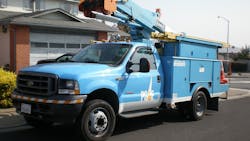PG&E Receives State Approval for Investments Aimed at Reducing Wildfire Risk
The California Public Utilities Commission (CPUC) recently approved most aspects of a multi-party settlement agreement between Pacific Gas and Electric Co. (PG&E) and customer advocacy, labor, and safety groups that resolved the PG&E's 2020 to 2022 General Rate Case (GRC), which includes the utility's ongoing efforts to reduce wildfire risk and continue delivering safe and reliable service to customers.
The GRC decision enables necessary investment in the PG&E's electric and gas distribution systems and power generation infrastructure, including investments to reduce the risk of catastrophic wildfires through electric system hardening, enhanced vegetation management, system automation, and asset inspection and repair.
The GRC also enables the PG&E to continue its efforts to make Public Safety Power Shutoff (PSPS) events smaller in size, shorter in duration, and smarter in execution. Those efforts include devices that limit the size of outages to impact fewer customers; temporary generators to provide power to essential services and communities that would otherwise be shut off for safety; crews for inspection and restoration efforts; and customer notifications in 13 languages that provide estimates about when power will be shut off and restored.
"The safety of our customers and communities we are privileged to serve is where everything begins for the PG&E. It's our most important responsibility. We want to work to exceed our customers' expectations when it comes to safely and reliably delivering clean energy, reducing wildfire risk in an ever-changing climate, and building a safe and sustainable energy system. We are pleased that the recent action by the commission approves much of the negotiated multi-party settlement, which allows us to continue those efforts and underscores our commitment to the 16 million people we serve," said Robert Kenney, PG&E vice president, regulatory and external affairs.
Among the important wildfire safety investments funded by the GRC are the following components of the PG&E's Community Wildfire Safety Program:
- Installing stronger and more resilient poles and covered power lines in high fire-risk areas;
- Increasing ongoing work to keep power lines clear of branches from an estimated 120 million trees with the potential to grow or fall into overhead power lines, including annual vegetation inspection of approximately 81,000 miles of high-voltage electric distribution lines;
- Implementing SmartMeter technology to more quickly identify and respond to fallen power lines;
- Expanding the network of weather stations to enhance weather forecasting and modeling by adding 1300 new stations in high fire-risk areas by 2022; and
- Installing nearly 600 new high-definition wildfire detection cameras in high fire-threat areas, increasing coverage across these areas to more than 90%.
While the 2020 GRC will help fund a series of important safety investments, it will not fund legal claims resulting from the 2017 and 2018 Northern California wildfires. It also will not fund any PG&E Corp. or utility officer compensation.
With the CPUC approval of the settlement agreement, the average monthly bill for a typical residential electric and gas customer will increase by US$13.44 a month. This includes US$10.40 for electric and US$3.05 for gas service. The 2020 GRC rate change, which incorporates bill impacts for 2020 and 2021, will be effective March 1, 2021, and will impact rates until Dec. 31, 2022.
"The PG&E's commitment is to keep customer costs as low as possible while meeting our responsibilities to safely serve our customers, even as our changing climate presents significant new challenges and risks," Kenney said.
To help reduce customer costs, the PG&E has identified an estimated average savings of US$1 billion per year in operational costs through 2025 from various cost savings initiatives. Cost savings initiatives include the sale of the PG&E's San Francisco General Office headquarters and move to Oakland, sale of surplus property, sale of excess renewable energy, renegotiation of power purchase agreements, strategic sourcing, and workforce management. These savings will help moderate the expected increase in customer bills to support infrastructure investment.
To take advantage of programs, tools, and savings opportunities, the PG&E recommends customers become more familiar with the following:
- Separate from the California Alternate Rates for Energy Program (CARE), income-qualified households with three or more persons can apply for the Family Electric Rate Assistance (FERA) Program at pge.com/FERA for an 18% discount on their electric bill.
- Relief for Energy Assistance through Community Help (REACH) provides income-qualified customers with financial assistance during times of hardship. Customers impacted by COVID-19 will be provided with up to an additional US$100 in bill payment assistance. The program is funded by the PG&E through tax-deductible contributions from customers and employees.
